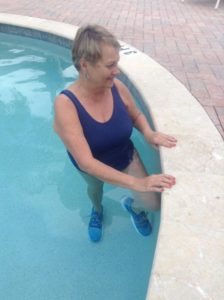Holding the pool wall might not be known for advancing an exercise, but it should! Did you know that stability enhances mobility and with greater stability isolated muscle strengthening is possible?
Think about a time when you’ve been nervous or scared. What does the body do? Shoulders rounded, muscles tense and perhaps the body is a little slow to move. These protective tendencies are also instinctive during exercise. If you have joint pain, or you’re trying an exercise for the first time, it’s natural for the body to select a position and movement that feels safe. Even for experienced exercisers, you’ll notice things like securing better balance by widening the base of support, crouching down or rounding the body. Furthermore, the muscles may tense, range of motion reduce and perhaps the joints start moving in tandem rather than independently.
Are you quick to get students away from the pool wall? I know I was. Not wanting my students to rely on the pool wall, I encouraged free standing exercises. Humbled by the intelligence of the body, I learned the value of stability and the benefits to all fitness levels. Not only could the pool wall be used to help relax and build confidence but also to improve mobility and stability. With this lesson learned, I had my fit college students seeking better athletic performance and seniors looking to improve balance, both using the wall to get better results.
Enhancing Mobility
When the body senses greater security, it feels confident to move in a greater range. Feel it for yourself. In the pool, or on land, try a single leg balance reach.
- Standing on one leg reach the other front to back.
- As you go through the exercise, keep the heel of the standing leg down.
- Notice your range of motion.
Try that same exercise, this time holding the pool edge or wall for support. What happened to your range? I am confident that you were able to move through significantly more range when adding the second point of stability. This example demonstrates how adding points of stability provides a sense of security and allows for more mobility. Hence, stability enhances mobility.
Coach Tip: Intersperse mobility exercises at the wall throughout the workout. Be sure to include exercises that target the neck, shoulder, trunk, hips and ankles. Use in combination with strength and cardio exercises to keep the body warm and deliver a well-rounded program.
Enhancing Strength
If you read my previous blog article, “Hip Exercises for Whole Body Results”, you learned that the glute muscles forgetting how to engage, is a reality that affects many. This can be true of any fitness level as the body finds a way to get through a movement, even if it’s not the most effective. The problem occurs overtime when helper muscles break down from over use causing pain, injury or dysfunction. Great news! The pool wall can also be used to wake up dormant muscles and improve strength.
 Try this isometric glute activating and strengthening exercise:
Try this isometric glute activating and strengthening exercise:
- Stand perpendicular to the pool wall
- Bend the leg closest to the wall to 90 degrees and press against the wall
- Both hands hold the pool wall so you are rotated towards the bent leg
- Hold the isometric leg press against the wall for 45-60 seconds
- Relax and repeat 2-3 times
As you go through this exercise notice how holding the edge and pressing the leg against the wall creates rotation of the pelvis away from the wall, which engages the glutes on the standing leg.
Coach Tip: On land, gravity provides significantly greater overload to this exercise. On land or in the pool, this exercise is gentle enough for all fitness levels. Try it for yourself. Are your gluts quick to fatigue and feeling the burn?
To learn these skills and more, join WECOACH Workouts – my online water workout platform for all abilities.
